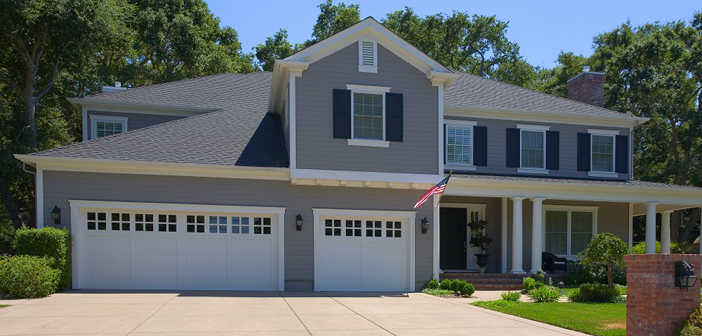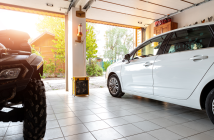The best feeling in the world is knowing that something or someone you are counting on is truly reliable. When it comes to your garage door, that reliability comes from a combination of quality parts and regular maintenance. If you’ve never given a second thought to the inhabitants of your garage, or the door that protects them, this is the year to get started. Garage door maintenance is a year-round project for homeowners, but your efforts will be rewarded by a garage door that’s quiet, dependable and long-lived.
We’ve broken down the regular maintenance tasks you’ll need to perform into seasons to make the whole process much easier. Some tasks should be performed monthly, others seasonally and a few can be checked just once a year.
Spring: A Time for Garage Door Check-Ups
Spring and fall will be the busiest times for your garage door care regime. In the spring, you’ll be repairing winter damage; fall is all about preparing your door and opener for what winter may bring. Here are a few things you absolutely must do in the spring:
Clean, re-caulk and repaint. Your garage door took a pounding this winter, between the frequent temperature changes, melting snow and the salty slush that was splashed against it, now’s the time to ensure that it’ll manage another season after all that stress. Clean your door thoroughly, and check the caulked seams and replace them if they’ve shrank or are coming loose. Adding a new coat of paint if the finish is looking thin will help help keep your door at its best.
Break out the lubricant. Over time, the lubricant you’ve applied to your garage door’s parts breaks down, leaving it struggling to move like it should. Make sure to lubricate your rollers, torsion springs and brackets during the springtime.
Balance your door. This is a task you should perform every season, not just in the spring. You’ll just need to disconnect the door, push it up to about three feet off the ground and see what it does. If it stays put, it’s balanced, but if not, you’ll need to adjust your door’s spring tension, depending on what direction it goes.
Opener reversal testing. Your door should automatically reverse if it contacts something in its path. You can test this feature by laying a standard 2×4 in the path of the door and closing it. If the door bounces back up, you’re set — if not, you’ll need to adjust the opener’s force setting or call in a pro.
Photo eye testing. Like the reversing feature on an opener, the photo eyes help keep your door very safe. When the something passes through the beams emitted by the photo eyes, the door should quickly reverse — if it doesn’t, check their positions. The photo eyes should be pointing at one another, with their individual LEDs lighted.
Summer: Seal It Up for Efficiency
Summer’s a great time to think about your garage door seals. Even though you can replace seals at any time of the year, early summer weather is perfect for this type of outdoor work. By ensuring you’ve got good, tight seals in place, you’ll also increase your garage’s energy efficiency and prevent bugs and critters from invading your garage. Run down this short list before summer fun gets underway:
Check and replace seals. The best way to check your seals is by shutting the door and looking hard for areas where light is penetrating. You can check at night from the outside with the garage lights on or from the inside during the day — either way, the contrast makes it easy to see exactly what needs replacing. Many garage door experts recommend replacing all your seals at the same time, but if you don’t have the time or funds, replace those that are showing wear first and work your way around to the seals that are still intact.
Inspect your door’s hardware. The rollers and hinges on your door aren’t made to last forever and will eventually wear out. Check them for signs of damage, like loose screws or rust, and replace them as needed.
Don’t forget your safety checks. Even though they’re listed under Spring, you need to do door safety checks throughout the year. Check your door’s balance and ensure the safety features are still working at least once a season.
Fall: Getting Ready for Winter
Despite the beautiful falling leaves, you’ve got some work to do in fall when it comes to your garage door. Now is the time to find and fix the problems that could become catastrophic when the cold weather starts. Here are some of the most important tasks for fall:
Deal with Dings and Dents. Summer is hard on garage doors, especially if your kids play near the garage. Metal doors often get dinged or crushed from violent spring and summer weather or take a beating from errant balls — no matter the cause, they’ve got to be fixed. Metal doors are especially bad at cracking under the constant freeze and thaw patterns in winter, those damaged spots are often the focal point for major metal fatigue.
Time to lube again. You just lubed your garage door last spring, but it’s time to do it again. Lubrication is a twice-yearly task and doing it in the fall gives you great weather for the task! Remember to hit the hinges and rollers, as well as the garage door opener’s moving parts.
Safety checks. All the safety checks you’ve done so far need to be repeated. So, check those eyes and make sure your door will still reverse properly. Winter is a hard time for your garage door, by ensuring that absolutely every part is in tip top shape, your door will have the best chance of making it through unscathed.
Winter: Time to Watch and Prepare
Winter’s a tough time for most of the country — and your garage door knows it. The changes in the weather put it under a great deal of stress, but if you did all your checks throughout the year, you shouldn’t have any surprises. Mostly, winter is light duty, but make sure you do these things:
Regular maintenance checks. You still need to do the safety checks you did throughout the year, like checking the reversing system on your opener and making sure your photo eyes are working well. Pick a warmer day to do these items, since pockets of ice between garage door sections and frost on photo eyes can skew your results.
Watch for weather-related changes. Depending on what winter looks like where you live, your door may suffer a number of winter-related problems. That freeze and thaw cycle we discussed earlier is among the hardest things your door has to deal with. When precipitation melts from the sun, but gets trapped inside the hinges and between your door’s sections and refreezes, there can be considerable damage. Usually, these changes happen a little at a time: a screw working out of a hinge or frozen seal will mean repairs down the line.
No matter where you live, it’s important to take proper care of your garage door. By dividing your garage door repair into seasons, it reduces the workload and allows you to spend your energy at times when it’ll help your door and opener the most.




